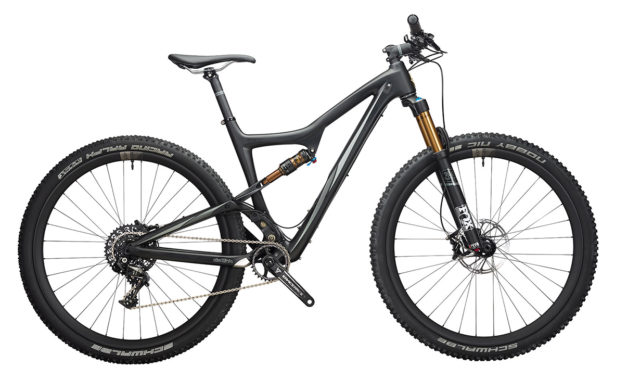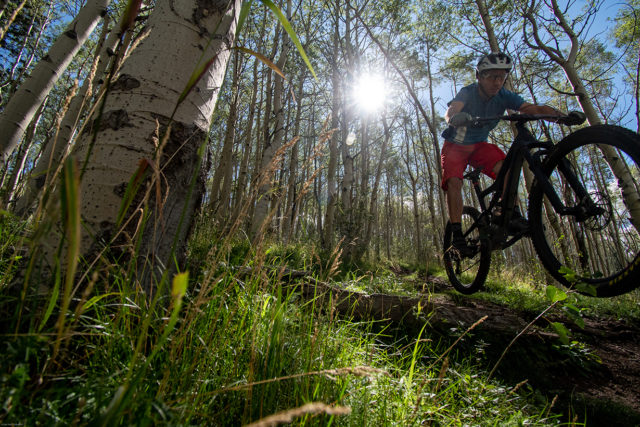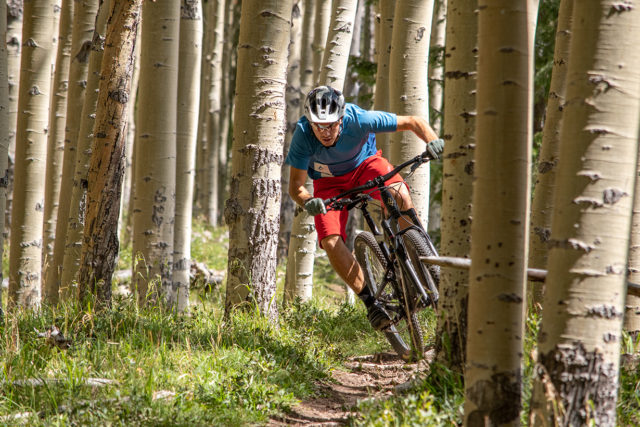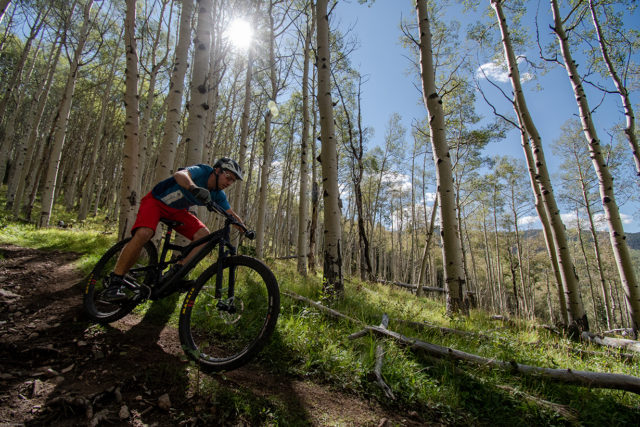2017 Ibis Ripley LS
Size Tested: XL
Geometry: (Here)
Build Overview (as tested):
- Drivetrain: SRAM XO1 Eagle
- Brakes: SRAM Guide RSC
- Fork: Fox 34 Float 29 140 Factory
- Rear Shock: Fox Float Factory
- Wheels: RaceFace Aeffect-R Boost Wheel
Wheel Size: 29”
Travel: 120 mm Rear / 140 mm Front
Blister’s Measured Weight: 27.25 lbs (12.4 kg) without pedals
Reviewer: 6’0”, 165 lbs.
Test Location: Santa Fe / Albuquerque, New Mexico. Colorado Trail. Poncha Springs, Colorado.
Test Duration: 1 month
MSRP: $6,699 (for current X01 build)

Intro
These days it seems like longer-travel Trail bikes and even burlier Enduro bikes get all the press. And there’s definitely some reasoning behind the excitement — over the years, longer-travel bike have gotten more and more efficient, and in turn, more versatile.
But, versatile as they may be, those longer-travel rigs still give up a fair amount of ground on the way up, so what about people who want more efficiency, but still want to ride hard on the way down? That’s where the class of shorter-travel Trail bikes comes in, and while that idea isn’t really new anymore, we think lots of people could be better served by something that falls well below the “Enduro” level.
The Ibis Ripley LS falls into that short travel and efficient category, so how does it stack up in a fairly competitive field of bikes?
The Ibis Ripley first came out in 2013, and the first iteration was designed to be a light and capable Trail bike that would be comfortable in a wide variety of terrain.
Then Ibis released the Ripley LS (“Long and Slack”) in June of 2015, and this bike was built to compete in the growing class of capable 29ers that are still efficient and light. I had done a quick demo a couple years ago on the Ripley LS when it came out, and had been anxious to spend more time on it after a great first ride. I’ve now ridden the Ripley LS for about a month, and have a good idea of where it slots into the large category of Trail bikes.
This year, Ibis released an updated Ripley LS, which features minor adjustments in frame stiffness and tire compatibility. I’ve been riding the first-generation of the Ripley LS, but since the changes to the 2018 Ripley LS are pretty minimal, the majority of what I say here will hold true for the new Ripley LS, apart from a few areas that I’ll touch on.
The Build
Ibis offers a range of build kits for the Ripley LS, starting with the Sram NX kit, which comes in at $4,099 MSRP.
The version of the Ripley LS I’ve been riding is the previous X01 build, which features Fox suspension and mostly Sram and Race Face components. The build kit offerings have changed a bit since I got my bike, but the build I’ve been using is roughly equivalent to the current X01 build, which goes for $6,699.
The Ripley LS X01 build I tested didn’t skimp on suspension and drivetrain components, with Fox Factory suspension and SRAM XO1 Eagle drivetrain with carbon X01 cranks. The 2018 Ripley LS comes equipped with the Fox Performance Series suspension rather than the Factory Level. The X01 Eagle is a wonderful performer and matches nicely with what the Ripley LS does well — go uphill fast and rip it on the way down. A 32t front ring with 10-50t range in the back allows for all sorts of terrain and long days on the bike. As many people have discovered, the B tension can be a little tricky to dial in, but once it is, shifting is very smooth.
The X01 Ripley LS I was on was equipped with a 140 mm Fox Float 34 Factory Series and Fox Float Factory Series rear shock which meant I got the top-of-the-line damper and the Kashima-coated stanchions.
The current Ripley LS X01 is equipped with a 130 mm Fox Float 34 Performance Series fork and Fox Float DPS Performance Series EVOL 7.25 x 1.75 rear shock. Fox’s main competitor for the fork would be the Rock Shox Pike, which I actually ended up using for a few rides. The Pike is stiffer but also heavier, and I’ve liked the Float 34 Factory overall. The Fox Float 34 Factory reach shock and its three settings worked really well with the Ripley LS’ DW link design (more on that later).

The wheels and cockpit added some weight on the build I tested, as it came stocked with RaceFace Aeffect wheels, bars, and stem. These are all good, more-affordable products, but they’re definitely on the heavier side and sacrifice some stiffness. The wheels are relatively stiff and supportive for alloy wheels, but to take this build to the next level, I think carbon wheels would be a great upgrade to maximize stiffness and to help shave off some rolling weight.
The Ripley LS XX1 build is the next step up from the X01 build. The XX1 build adds on Ibis’ 942 carbon wheels, carbon bars, etc., and swaps out the Fox Performance Series suspension for a Float 34 Factory fork and Float DPS Factory rear shock. The current Ripley LS with the XX1 build would set you back $9,399.
To go along with the some of the Race Face components was the Race Face Turbine dropper post. This is a great post with easy maintenance compared to something like the Rock Shox Reverb (the Reverb is cable-actuated vs. the Turbine, which is hydraulic).
The only problem I’ve noticed is in regard to the Turbine’s standard lever. I would prefer having a front shifter-style lever rather than the awkward push-down lever that can result in some knee-smashing on the super tight switchbacks of Santa Fe, or when I’m way up out of the saddle and absolutely smashing it on the pedals. On top of that, reaching up for the lever isn’t quite as optimal as a front shifter-style lever. That said, Race Face does make a 1x lever for the Turbine post which would be a worthwhile upgrade. The current Ripley LS X01 build comes with a Fox Transfer post which already has a 1x-style lever.
I’ve been using (and liking) Shimano XT brakes for years, but the SRAM Guide RSC brakes on the Ripley LS have performed pretty well overall. Their modulation is superior to XT brakes, though the XT brakes seem to have a bit more “bite” than the Guide RSC. Even when running the same rotor sizes on other bikes, the XT felt quicker to bite when hitting the brakes. The Guide RSC brakes do feel smoother, but they’re also noisier. The Ripley LS came stocked with a 160 mm rear rotor, but if you wanted to deck out this bike to optimize downhill performance, it does allow for a 180 mm rear rotor (the current X01 build comes with 180 mm rotors).
As for rubber, the Ripley LS build I tested came with a 2.4” Continental Mountain King in the front and a 2.2” Mountain King in the rear (the current X01 build comes with Schwalbe Nobby Nic 2.6” front and back). The Mountain Kings are not the best tires in the world, but since tires wear down fast and are easy to swap out, I don’t think this is the biggest deal.
The weaker casing of the Mountain Kings ended up not being able to stand up to what the Ripley LS was capable of when pointed downhill — I ended up slicing the sidewall early on in the life of the 2.2” rear tire. Personally, I’d prefer a Maxxis combo like a Minion DHF 2.3” up front and Maxxis Aggressor 2.3” in the rear, preferably with a tougher casing.
Frame and Design
The Ripley LS’ entire frame is carbon fiber. For those wanting an aluminum option, you’re out of luck; the Ripley LS is only offered in carbon.
The frame is designed with the DW link platform. Designed by Dave Weagle, the DW link is used on the Ripley LS to create a suspension platform that remains efficient enough where energy isn’t wasted through bobbing while still remaining compliant over bumps.
For more on suspension designs and how they differ, check out our Suspension 101 article.
The DW link is used on all of Ibis’ bikes. The Ibis bike that’s most comparable to the Ripley LS (on paper) is the Mojo 3, which is similar in travel but intended to be the plus-sized little brother to the Mojo HD 4, Ibis’s Enduro rig. Ibis’s new long-travel 29er, the Ripmo (review coming soon), is slacker, longer, and has more travel than the Ripley LS, and is also intended to be a bit more of an Enduro bike.
While all of Ibis’ models use the DW linkage, there are some differences in the way that it’s set up on each bike. The Ripley LS uses eccentric pivots on its DW link. This consists of a super clean attachment point between the swingarm and the frame that almost looks like a single-pivot design. The Mojo HD4 and Ripmo use the more traditional DW linkage with two short links creating a parallelogram of sorts.
I think the biggest advantages / disadvantages between these different DW-link designs come from a maintenance standpoint, rather than a performance standpoint. The Ripley LS started creaking pretty early on in its life where the swingarm attaches to the eccentric bearings. While it’s not the most difficult thing in the world, taking apart the eccentric bearings is a process that requires a bit more mechanical skill compared to a regular shortlink like that on the Mojo HD4. The upside of the eccentric bearing is a more compact design that probably also saves a bit of weight.
The Ripley LS is designed with internal cable routing (for the most part). The rear brake remains external, which I like — if you ever want to swap brakes, you don’t have to deal with bleeding the brake, you just need to cut a few zip ties. The rear derailleur cable goes through the front triangle, briefly pops out, and then continues through the seat stay. Swapping cables isn’t too much of a challenge but does require a bit of fishing to get the cable through the frame as there aren’t any “tubes in tubes.” All in all, it’s an easy and clean design.
The Ripley LS’ dropper-post routing is awesome and simple to maintain. A clean run through the frame and another brief pop out right before the seat tube makes things easy, and the turn from the downtube to seat tube is clean. I think Ibis hit the routing spot-on here.

The Ripley LS come stock with a plastic downtube frame guard, which is always nice to have. It attaches to the lower bottle mounts, but you’re still able to use the frame guard and have a bottle cage down there. Speaking of bottle cages, I think it’s awesome that there are spots for two, especially since this bike is so capable on long rides (more on that later). The only downside of the bottle cages is that the cage inside the Ripley LS’ frame is actually a bit hard to reach down for. It’s not a big deal, but worth noting. Lastly, I found that the internal cage mount leaves enough space for a large bottle.
As with some of their other bikes, Ibis has designed a frame bag for the Ripley LS that slots above the rear shock in the front triangle, which is super cool. And if you don’t want to spend $50 dollars on that, there’s ample space to tape or strap on a tube and some CO2. With two spots for bottles and a spot for a small frame bag, bring some water purification and the Ripley LS is ready for some long, pack-less days.
A huge plus for me on the Ripley LS is definitely the threaded bottom bracket. I find them to be much easier to clean, replace, etc., and all with less creaking than press-fit options.
All in all, the frame of the Ripley LS seems really well designed to make things stiff and relatively easy to maintain and clean.
Fit and Geometry
I was riding the size XL Ripley LS (I’m 6’0”, 165 lbs). It feels pretty similar overall to other XL bikes I’ve ridden, like the Santa Cruz Tallboy and Trek Slash. The XL Ripley LS’ reach at 448 mm is comfortable for me, but it’s still a good bit shorter than other XL frames. (For example, the Santa Cruz Tallboy’s reach comes in at 475 mm.)
The Ripley LS’ chainstays are on the long side of average at 444 mm. They’re long enough to provide stability, yet short enough to be playful and poppy for a 29er.
The headtube angle is 67.5 degrees, which is slacker and better at smashing through rock gardens than the original Ripley, but still upright enough to provide efficiency when turning the pedals. For a 120mm-travel frame, 67.5° is slack and ready to attack the descent.
I’m 6’0” with pretty much all legs and a short torso, so I run 175 mm cranks. The Ripley LS was equipped with a 125 mm dropper post, so I am running a bit more post out than I’d like. But with a long seat tube length of 521 mm, it shouldn’t be a problem for folks with normal-length legs.
The Ride
The Ripley LS was designed to be versatile and handle long days on any terrain. And for that purpose, I think Ibis nailed it. While I wouldn’t say that it absolutely excels on any particular terrain, the Ripley LS is definitely comfortable in a wide variety of terrain.
For a bike in this class, the Ripley LS’ efficiency while climbing is top-notch. The DW link really helps minimize bobbing in back because of the emphasis put on load transfer. While still compliant through bumps, the downside to that efficiency of the load transfer is that it feels a bit harsher on really rough trails.
For example, the DW link on the Ripley LS doesn’t react as quickly as Trek’s ABP system. I normally run around 25% sag on most bikes, but have upped it to around 30% on the Ripley LS to try to get a bit more liveliness out of the rear end. This didn’t lead to any bottoming out issues, though I wasn’t necessarily seeking out any huge hits to test that. The Ripley LS definitely seems to be geared toward efficiency, whereas other designs (e.g., bikes with the ABP design) are aimed more toward small-bump compliance. Still, for a bike with 120 mm of rear travel, the Ripley LS is not a bad performer even when conditions get a bit chunky.

As stated earlier, the Fox Float Factory shock with the CTD switch allows for three riding settings, and the DW link works really well with this feature. With the shock fully locked out, the Ripley LS feels almost like a hardtail on smooth climbs. Trail mode allows the comfort of still getting a response from the shock while keeping the bike very efficient when mashing on the pedals. Leaving the shock fully open brought the bike to life on the descent.
So just as we climb, ride trails, and descend on big rides, the Ripley LS really helps these three modes feel distinctly different when that lever is flipped and allows for a comfortable ride during long days in the saddle. Of course, other bikes that have this shock will also offer three different modes, but I thought the three-position shock felt particularly useful on the Ripley LS. You can really differentiate between the three modes, whereas on other bikes I’ve ridden, the difference between the Trail and Open positions is a bit less noticeable.
The Fox Float 34 Factory fork has the same 3-position adjustment as the rear shock, and is equally as effective at giving you plenty of options throughout the ride when it comes to how you want your suspension to work. The 140 mm of travel on the fork I tested is enough to really let loose on hard descents. 140 mm front suspension and 120 mm rear suspension is a combo that I’ve found works well to make the bike handle varying terrain competently without giving up too much ground on either the climbs or descents.
Technical uphill terrain is an area where I think the Ripley definitely excels. Rolling over chunky terrain is easy with its wagon wheels, and the DW link gives the bike an almost floaty feel with endless traction. I generally had the shock in open or trail mode when rolling through technical uphill terrain. This allowed for some forgiveness over the rough terrain. Since the Ripley LS is such an efficient bike, a ton of efficiency isn’t lost when the shock is in the open or trail modes.
I’ve mostly been riding the Ripley LS around Santa Fe, NM, where the riding is very steep and loose. With the 50t gear in the back, getting up steep, loose, rocky terrain was no problem on the Ripley LS, and the 67.5° head tube angle and 73° seat tube angle kept the bike in an upright position that made climbing feel natural.

Being a size XL 29er, it’s no surprise that this machine may struggle on super steep, tight, corners. But while the Ripley LS took some getting used to, I still found it to be capable of getting through even the most awkward of corners. On an off day, the Ripley is a bit tougher to pilot through that type of terrain compared to a 27.5” bike like the old Trek Slash, but I was still surprised by how nimble and playful the Ripley LS was for the XL size I chose and its 29” wheel size.
I think the Ripley LS really comes alive on hilly, fairly twisty terrain, with lots of steep ups and downs with swooping corners, rough sections, and punchy climbs. That’s when I felt I was riding this rig to its full potential — days when I needed to hammer up a climb, initiate the dropper post, and let loose for a bit on the down.
Equipped with two spots for water bottle cages, the Ripley LS definitely works well for all-day epics. Put in that small frame bag from Blackburn, toss on a handlebar bag and a seat bag, and this thing would be super comfortable taking you out on a couple nights in rugged terrain. If you want a bike that will do it all, not always amazingly well, but something that you can be confident on in virtually any terrain, the Ibis Ripley LS could be a good option.
Bottom Line
While a 160 mm Enduro bike is a ton of fun on descents, plenty of people want to prioritize the climb a bit more while not totally giving up the ability to pin it back down. And I think the Ibis Ripley LS strikes a nice balance for such riders.
The Ripley LS would be a good option for endurance racers that face varying terrain or just people who like to ride their bike no matter what is thrown at them. If you’re looking for a full-on 29er XC race bike, then there are better options. And if you’re looking for an Enduro bike for really gnarly descents, you should probably look for something with more travel. But sandwiched between those two categories sits the Ripley LS, and it’s a bike I think a lot of people will like.
Compared to other bikes in this category, I think what sets the Ripley LS apart is just how well it can do everything. As I said before, it doesn’t exactly excel in any one category, but the performance overall is excellent. Other bikes in the same sort of category may excel in climbing or descending, but the Ripley is a safe bet if you’re looking for solid performance in both areas.

Why not call it what it really is, SS, short and steep.
You talk of prioritizing the uphills, but I think the real value of shorter travel, steeper bikes lies in rolling terrain.
Plenty of long travel, slack bikes climb well these days, and can effieciently grind out a 2000’ climb. The difference isn’t so much speed as it is fun:
On rolling trails, with short ups and downs, a nimble, quick, poppy bike allows you to pump the terrain and whip through tight corners at the lower speeds that those trails(like we have here in MN) lead to.
For sure! Totally agree. I think I mentioned how much the bike came alive when the terrain was rolling with lots of turns, punchy climbs, downhills, etc. The Ripley LS felt alive in this terrain especially. Although it doidn’t do terribly grinding up a 2000′ climb either!